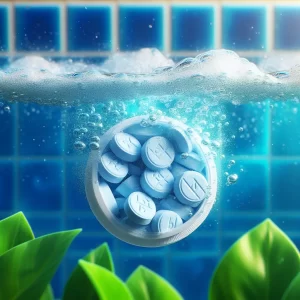Maintaining the appropriate level of residual chlorine in swimming pools is crucial for ensuring water quality and the safety of swimmers. Residual chlorine, commonly measured in the form of free chlorine or combined chlorine, plays a vital role in disinfecting pool water and preventing the spread of waterborne illnesses. This article explores the significance of residual chlorine, the factors affecting its levels, and effective strategies for its control in swimming pools.
The Importance of Residual Chlorine
Residual chlorine is the chlorine remaining in the water after the initial disinfection process. It serves as a continuous sanitizer, eliminating bacteria, viruses, and other harmful microorganisms introduced by swimmers or external contaminants. Maintaining an adequate residual chlorine level is essential for preventing waterborne diseases, skin irritations, and eye discomfort.
Factors Affecting Residual Chlorine Levels
Several factors can influence the concentration of residual chlorine in swimming pools:
- Bather Load: The number of swimmers directly impacts chlorine consumption. Higher bather loads result in increased organic and inorganic contaminants, requiring more chlorine for effective disinfection.
- Temperature: Warmer temperatures accelerate chlorine breakdown, necessitating more frequent chlorination to maintain appropriate residual levels.
- pH Levels: The pH of pool water affects the efficiency of chlorine. Imbalanced pH can lead to reduced disinfection efficacy, requiring adjustments to maintain adequate residual chlorine.
- Sunlight Exposure: Ultraviolet (UV) rays from sunlight can deplete chlorine levels. Outdoor pools may require additional chlorine or stabilizers to counteract the effects of sunlight.

Strategies for Residual Chlorine Control
Regular Monitoring
Regular testing of chlorine levels is fundamental. Pool operators should use reliable test kits to measure both free and combined chlorine levels, ensuring they fall within recommended ranges.
pH Regulation
Maintaining a balanced pH is crucial for chlorine effectiveness. The ideal pH range is typically between 7.2 and 7.8. Regular monitoring and adjustment of pH levels contribute to stable residual chlorine.
Chlorine Stabilization
Stabilizers, such as cyanuric acid, can be added to pool water to prevent chlorine degradation caused by sunlight. This helps maintain a consistent residual chlorine level in outdoor pools.
Shock Chlorination
Periodic shock chlorination involves adding a higher dose of chlorine to rapidly eliminate contaminants and boost residual chlorine levels. This is particularly beneficial after heavy pool usage or contamination events.
Bather Education
Educating pool users about proper hygiene practices, such as showering before entering the pool, can minimize the introduction of contaminants and reduce the demand for chlorine.
Automation Systems
Utilizing automated chlorine dosing systems ensures a continuous and accurate supply of chlorine based on real-time water quality data. This enhances efficiency in maintaining residual chlorine levels.
Conclusion
Effective control of residual chlorine in swimming pools is essential for creating a safe and enjoyable swimming environment. By understanding the factors influencing chlorine levels and implementing proactive strategies for control, pool operators can ensure optimal water quality, minimize health risks, and enhance the overall swimming experience. Regular monitoring, pH regulation, and the use of advanced technologies contribute to achieving and maintaining the desired residual chlorine levels in swimming pools.





